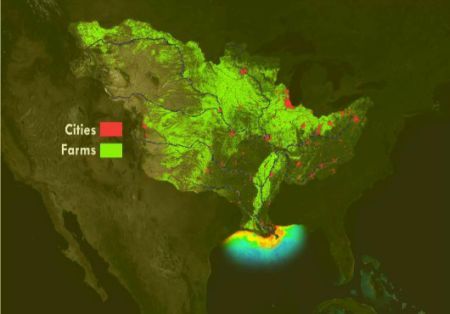
NOAA-supported modeling is forecasting this year’s Gulf of Mexico hypoxic zone to cover an area ranging from about 4,633 to 5,708 square miles (12,000 to14,785 square kilometers) or about the size of the state of Connecticut.
Hypoxic zones are areas in the ocean of such low oxygen concentration that animal life suffocates and dies, and as a result are sometimes called “dead zones.”
One of the largest dead zones forms in the Gulf of Mexico every spring. Each spring as farmers fertilize their lands preparing for crop season, rain washes fertilizer off the land and into streams and rivers.
The scientific models also account for the influence of variable weather and oceanographic conditions, and predict that these can affect the dead zone area by as much as 38 percent.
NOAA-supported modeling is forecasting this year’s Gulf of Mexico hypoxic zone to cover an area ranging from about 4,633 to 5,708 square miles (12,000 to 14,785 square kilometers) or about the size of the state of Connecticut.
While close to averages since the late 1990s, these hypoxic zones are many times larger than what research has shown them to be prior to the significant human influences that greatly expanded their sizes and effects.
A second NOAA-funded forecast, for the Chesapeake Bay, predicts a slightly larger than average dead zone in the US largest estuary.
Because of the shallow nature of large areas of the estuary the focus is on water volume or cubic miles, instead of square mileage as used in the Gulf.
The dead zone in the Gulf of Mexico affects nationally important commercial and recreational fisheries and threatens the region’s economy.
The Chesapeake Bay dead zones, which have been highly variable in recent years, threaten a multi-year effort to restore the water and habitat quality to enhance its production of crabs, oysters, and other important fisheries.
Hypoxic (very low oxygen) and anoxic (no oxygen) zones are caused by excessive nutrient pollution, primarily from human activities such as agriculture and wastewater, which results in insufficient oxygen to support most marine life and habitats in near-bottom waters.
Aspects of weather, including wind speed, wind direction, precipitation and temperature, also affect the size of dead zones.
We use cookies to improve your experience. By continuing to use our site, you accept our Cookies, Privacy Policy,Terms and Conditions. Close X